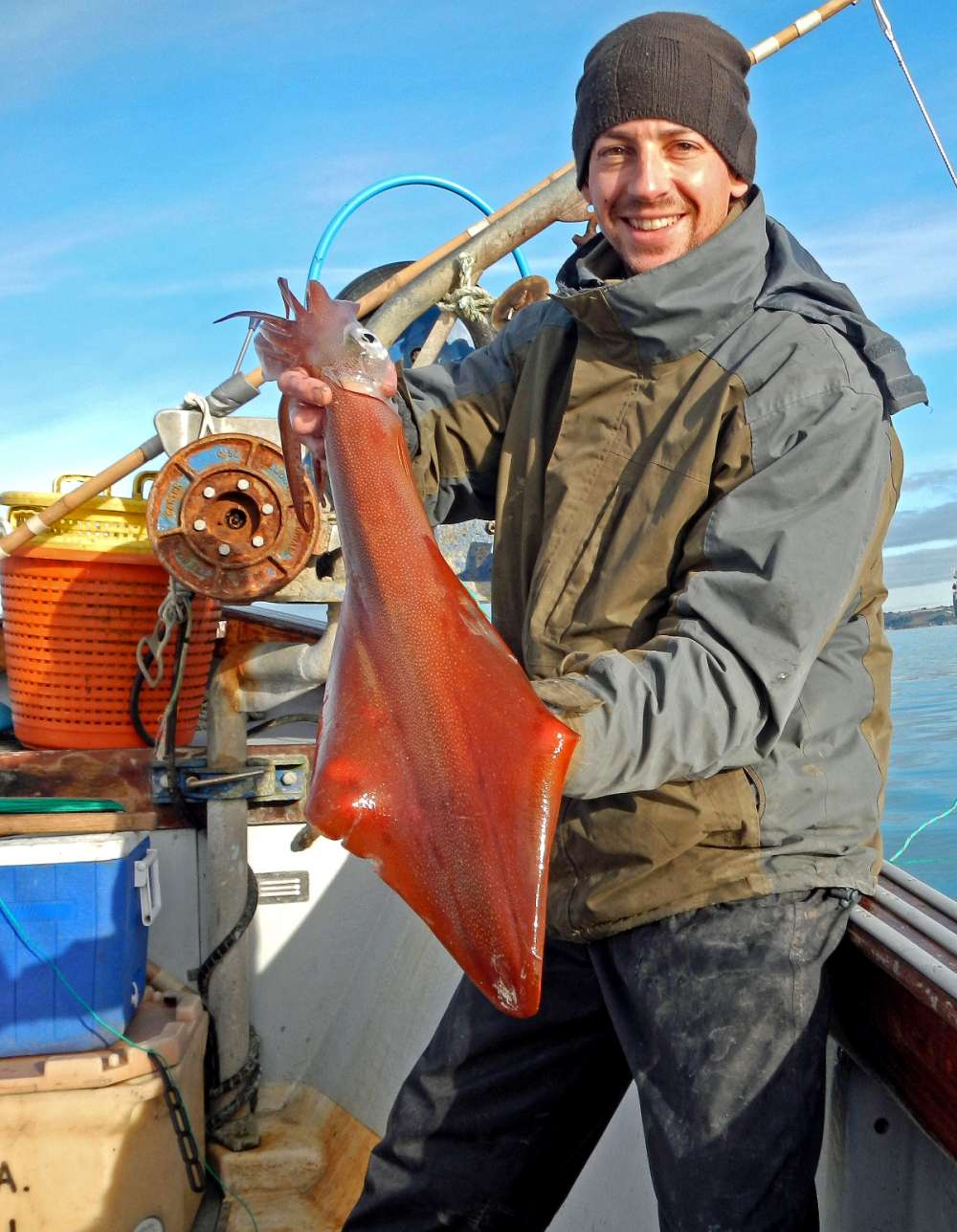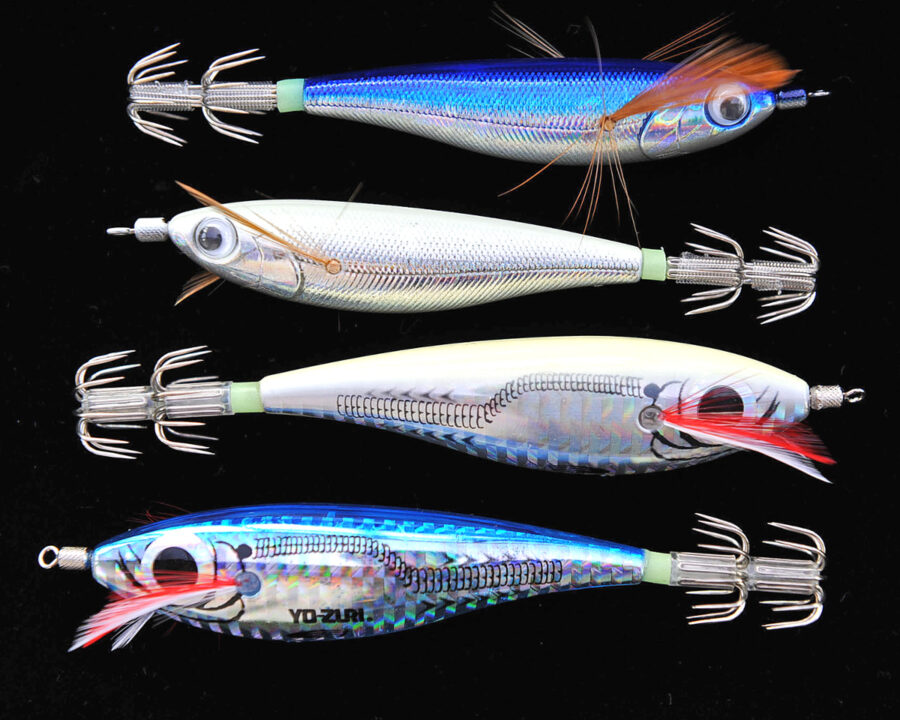In the first of a new six-part series, Phil Lockley recalls how he became addicted to squid.
Thoughts of a good squid season may tempt more inshore fishermen to try a fishery that either drives you mad or converts you into a squid fanatic. Autumn and winter linefishing for squid is an ‘extreme’ fishery, you either love it or hate it; there’s no midway point.
Mid-September should mark the start of the squid line-fishery. For the past 10 years, when chasing the most elusive species that surround the coasts of Britain, I have kept diaries of my catches and notes upon my thoughts. I would like to share those with you.
‘Before we begin, thank you, thank you, thank you,’ are the words from the Dr Hook song, The Millionaire; words that are so appropriate. Being far from an expert on line-fishing for squid, I am an addict and can only applaud the true masters of the art who helped me tackle the most difficult fishery I have ever experienced. At the start of the Westcountry squid jiggers’ season, everyone, including me, waits patiently to see whether we will have sight of the most challenging cephalopod in the world – the long-finned squid – Loligo forbesi.

Hooked on squid – Phil Lockley with 84kg of squid caught in Falmouth Bay, December 2012.
About 30 years ago, during the hours of darkness, I was diving on a shallow wreck in Falmouth Bay (Hera) and was literally surrounded by squid. My underwater torch was their target, and I experienced one of the most fascinating 20 minutes in my 30-plus years of diving. Remember that timescale – 20 minutes.
On joining Fishing News in 1984, I chased news stories and often reported on fisheries that were ‘new’ to the UK; the mid-1980s was a time when skippers were fast developing new styles and techniques. Little did we know that politicians – to hinder the fishing industry – would one day introduce controls to prevent the natural progression of ‘technical creep’?
Line-fishing or jigging for squid is far from new. ‘Squiddling’ is a sport that goes back hundreds of years, particularly in Dorset. As a kid in the 1960s, I saw contests take place on Chesil Beach between Portland and Weymouth, where dead pouting were threaded onto a wire trace – a big treble hook at the base – with the fish set head-down to make it all into a ‘squid jig’. Some years ago, I was corrected when referring to a ‘shoal’ of squid, being told that the old Dorset word for such a grouping is a ‘rudd of squid’.
During the mid-1980s, I heard of a 30ft boat at Mevagissey where the skipper had manufactured and fitted hand-powered jig machines made of steel, similar to those commonly used on boats in Japan and Korea. Being ‘keen as mustard’ to see it working I jumped aboard, yet in the hour of first light, although he and his crew had worked hard to prove the point, I saw just 10 or so squid dropping from that machine.
But that’s squid fishing, I was later to discover. One day you have a ‘hit’, then for several days you have either nothing or much smaller catches. So before you try jigging for squid – and I hope you do – be prepared to taste a ‘feast or famine’ fishery.

Commercial jigs, used in warmer climes aboard big craft with squid
jigging machines, were tried in the UK but found to be of little use
unless the shoals were huge.
In my opinion, there are openings in seriously high-level restaurants for British hand-linecaught squid; the demand is very high, it is a limited fishery, and perhaps that demand may never be fulfilled. Forget the £4/kg often seen at traditional fish market auctions, because the fishery is not viable at that level. And with the number of skippers being willing, or not willing, to take the unpredictability of squid fishing, no one can allow fickle merchants to make or break that fishery. There is a Cornish sardine association for the ring netters – let’s have the same for our equally small fishery; and while we are in Europe, secure whatever name we call in. The product is exceptional.
Cornwall inshore fishermen too are ‘long in the tooth’ as far as squid jigging is concerned. When crabbing in the late 1970s, I often saw boats nearby with lines carrying commercial squid jigs, ones held on ‘end-on-end’ traces. Those jigs were made in Japan and were imported to the UK by Transatlantic Fishing Systems at Penryn and Parkes Weston at Plymouth. I heard of 40 stone of large squid being taken by one boat in one morning, thought little of it and wasn’t swayed away from my pots and/or tangle nets. I should have been.
However, about 15 years ago I heard of success by a number of Cornish fishermen who were using ‘new’ jigs, also manufactured in Japan and imported to here; shrimp-like jigs with a weighted keel, that were commonplace among anglers in Asia, the Middle East, the Far East, Japan and further. I bought some.
Having a small part-time craft (my first Cygnus GM19, Charlotte Louise), my pal Richard and his son Harry jumped aboard, and we went to a sandy bank near the Manacle Rocks to test the jigs; me using the traditional-style commercial jigs, with Richard and Harry using the relatively fragile shrimp jigs. I had little confidence in either type. But drifting near a string of pots, wham – squid love to be by pots – I caught just one squid, but the other two had many more, and big ones too. I knew that there was a fishery of sorts. I bought many more shrimp jigs. However, with the demands of Fishing News work, for me the squid fishery took a back seat until I saw a committed winter squid fisherman in action; a well-known skipper from Falmouth, Jack Seabourne.
His catches were more continuous, often serious money-makers. He was using fish-like jigs, and begged me to say nothing in Fishing News and I complied. But I will never forget the help he gave me, often saying: “Always deny them the lure.” Rather than keeping the jigs still, by pulling the jigs away from the squid – oh boy, did it work – the catches were much higher. The faster he pulled the gear away from what were really big squid, the faster the squid attacked. I saw the violent behaviour of Loligo forbesi; the long-finned squid, one of two main commercial species in the UK.

Taimor Jolly holding a typical November squid that in about 12 months has grown from a tiny planktonic larva.
I quickly joined the small fleet of Falmouth squid jiggers, and soon filled-up my freezer, but writing work came first and spare time was rare, so my squid fishing became minimal.
Note – the other species, Loligo vulgaris, looks identical, but I rarely see that species when jig fishing. The visual difference is hard to find (see the photo) but in my opinion, Loligo vulgaris has a totally different behaviour pattern to Loligo forbesi.
In 2006, I bought my present GM19, Amanda J FH 9 and after a flippant tip-off I heard one night in the Ferryboat Inn, Helford Passage, I soon became addicted to squidding. Because in one, two-hour session, I had converted that tip-off into £230. I too had taken the ‘bait’ and remain devoted to squid fishing.
Perhaps my source had drunk one beer too many, or maybe my ears were extra sharp, but when he said that he had caught ‘five big squid in The Pit last night’, then pointed to a dip in the seabed just yards from the shore, thankfully I took him seriously.
I knew The Pit well. It was a hotspot when diving for scallops (no longer – local diving charter boats have made a meal of that, sad too because they have no right to, those shellfish belong to the Duchy of Cornwall).
I made plans to test his claim by using cheap shrimp jigs set on a trace of four jigs (100-pound Breaking Strain) BS main line with 80-pound BS snoods. I could hardly believe the result. In three hours I was covered in squid ink, the haul of 47kg was generally big squid, it was November, and when I got home my squid diary had its first entry.

Tentacle pad comparison – at the top is Loligo forbesi where the rows are of equal-sized suckers, and Loligo vulgaris where the centre suckers are much larger.
“Poor Head Chef,” I thought. After promising £5/kg, and that he would take every squid I caught that night, I was on a winner. However, his shift was over when I arrived with my catch, and I will never forget the look on the face of the Second Chef – he had to prepare the 50 or so squid ready for the tables and freezer. Some chefs reckon that squid tastes better after freezing. They certainly are a bit softer. My favourite squid recipe was given to me by a French trawlerman – squid stewed with tomatoes – I digress!
To conclude, I must refer to another Dr Hook song, ‘Everybody is making it big but me’ – because squid fishing on many nights will, to put it mildly, test your patience. Here are the lyrics, and try the songs on youtube.com – real old hippie music! Suits me quite well.
Elvis he’s a hero he’s a
superstar
And I hear that Paul
McCartney drives a Rolls
Royce car
And Dylan sings for millions
And I just sing for free
Oh everybody’s makin’ it big but
me
Oh yes, I hope you haven’t forgotten ‘20 minutes’.
Read more from Fishing News here.








